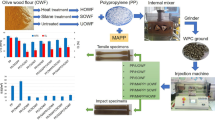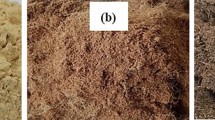Abstract
The main objective of this research was to study the potential of waste polypropylene and waste wood for making wood plastic composites (WPCs). The effects of nanoclay (NC), microcrystalline cellulose (MCC), and coupling agent (MAPP) on the mechanical and thermal properties were also studied. The results showed that mechanical properties of the composites made with MCC were significantly superior to those of unfilled. Addition of MAPP could enhance the mechanical and thermal properties of the blends, due to the improvement of interface bond between the filler and matrix. The significant improvements in tensile properties of the blends composites made with MAPP and NC were further supported by SEM micrographs. The thermogravimetric analysis indicated that the addition of 5 wt% MAPP and 3 wt% NC significantly increased the thermal stability of the blends compared to the pure PP. MCC could not improve the thermal stability. The experimental results demonstrated that the waste materials used are promising alternative raw materials for making low cost WPCs.





Similar content being viewed by others
References
Taherzadeh MJ, Karimi K (2008) Pretreatment of lignocellulosic wastes to improve ethanol and biogas production: a review. Int J Mol Sci 9:1621–1651
Kim H-S, Kim H-J, Lee J-W, Choi I-G (2006) Biodegradability of bio-flour filled biodegradable poly(butylene succinate) bio-composites in natural and compost soil. Polym Degrad Stab 91:1117–1127
Wang S-Y, Yang T-H, Lin L-T, Lin C-J, Tsai M-J (2007) Properties of low formaldehyde-emission particleboard made from recycled wood-waste chips sprayed with PMDI/PF resin. Build Environ 42:2472–2479
Nourbakhsh A, Ashori A, Jahan-Latibari A (2010) Evaluation of the physical and mechanical properties of medium density fiberboard made from old newsprint fibers. J Reinf Plast Compos 29:5–11
Li Q, Matuana LM (2003) Surface of cellulosic materials modified with functionalized polyethylene coupling agents. J Appl Polym Sci 88:278–286
Adhikary KB, Pang S, Staiger MP (2008) Long-term moisture absorption and thickness swelling behaviour of recycled thermoplastics reinforced with Pinus radiata sawdust. Chem Eng J 142:190–198
Laka M, Chernyavskaya S, Maskavs M (2003) Cellulose-containing fillers for polymer composites. Mech Compos Mater 39:183–188
Georgopoulos S Th, Tarantili PA, Avgerinos E, Andreopoulos AG, Koukios EG (2005) Thermoplastic polymers reinforced with fibrous agricultural residues. Polym Degrad Stab 90:303–312
Wang W, Sain M, Cooper PA (2006) Study of moisture absorption in natural fiber plastic composites. Compos Sci Technol 66:379–386
Morreale M, Scaffaro R, Maio A, La Mantia FP (2008) Effect of adding wood flour to the physical properties of a biodegradable. Compos Part A 39:503–513
Shebani AN, van Reenen AJ, Meincken M (2009) The effect of wood extractives on the thermal stability of different wood-LLDPE composites. Thermochimica Acta 481:52–56
Ashori A, Nourbakhsh A (2010) Reinforced polypropylene composites: effects of chemical compositions and particle size. Bioresour Technol 110:2515–2519
Annual book of ASTM standards (1999) American Society for Testing and Materials, 100 Barr Harbor Dr., West Conshohocken, PA 19428, United States
Meyrs EG, Chahyadi IS, Gonzalez C, Coberly CA (1993) Wood fibres/polymer composites: fundamental concepts, processes, and material options. Forest Product Society, Madison, USA
Stark NM, Rowlands RE (2003) Effects of wood fiber characteristics on mechanical properties of wood/polypropylene composites. Wood Fiber Sci 35:167–174
Masenelli-Varlot K, Reynaud E, Vigier G, Varlet J (2002) Mechanical properties of clay reinforced polyamide. J Polym Sci B 40:272–283
Author information
Authors and Affiliations
Corresponding author
Rights and permissions
About this article
Cite this article
Nourbakhsh, A., Ashori, A., Ziaei Tabari, H. et al. Mechanical and thermo-chemical properties of wood-flour/polypropylene blends. Polym. Bull. 65, 691–700 (2010). https://doi.org/10.1007/s00289-010-0288-8
Received:
Revised:
Accepted:
Published:
Issue Date:
DOI: https://doi.org/10.1007/s00289-010-0288-8




